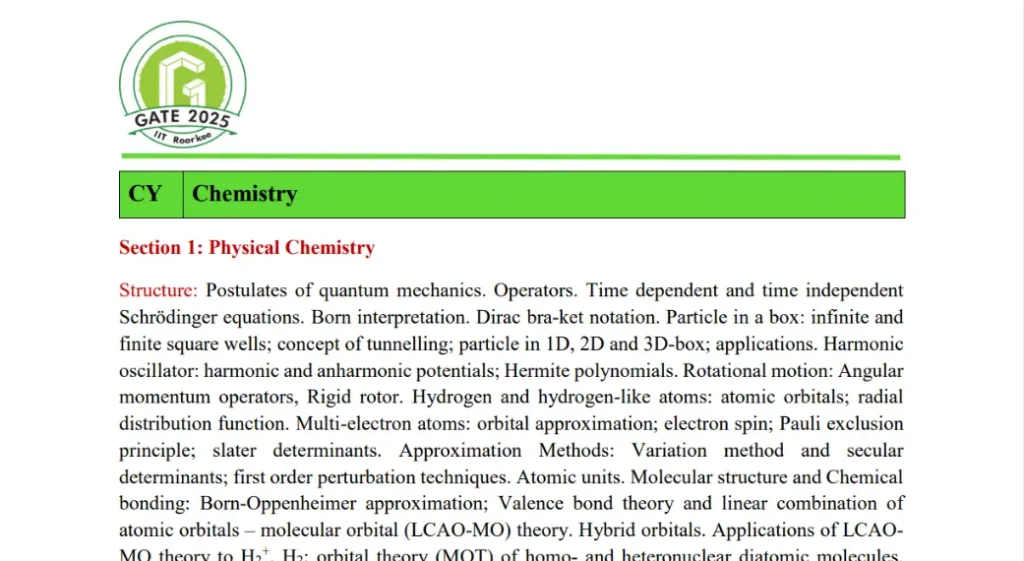The syllabus for GATE Chemistry (CY) 2025 has been officially released. Candidates aspiring to take the GATE 2025 exam in Chemistry can now access the detailed syllabus and begin their preparation in line with the updated content.
The Graduate Aptitude Test in Engineering (GATE) is one of the most competitive exams in India for students aspiring for postgraduate studies and career opportunities in the fields of research and development.
You can download the full syllabus for GATE Chemistry 2025 here: Download GATE 2025 Chemistry Syllabus (PDF)
GATE Chemistry (CY) 2025 Syllabus Overview
The GATE Chemistry syllabus is organized into three primary sections:
| Section | Topics Covered |
|---|---|
| Physical Chemistry | Quantum Mechanics, Thermodynamics, Kinetics, Surface Chemistry |
| Inorganic Chemistry | Main Group Elements, Transition Metals, Organometallics, Bioinorganic Chemistry |
| Organic Chemistry | Stereochemistry, Reaction Mechanisms, Organic Synthesis, Biomolecules |

Key Topics in Physical Chemistry
Quantum Mechanics: This part includes the postulates of quantum mechanics, Schrödinger equation, and the behavior of particles in one-dimensional, two-dimensional, and three-dimensional boxes. It also covers the quantum mechanical models for hydrogen-like atoms and multi-electron atoms, including atomic orbitals and electron spin.
Thermodynamics: This includes the laws of thermodynamics, Gibbs-Duhem equation, Maxwell relations, and thermochemistry. The syllabus also discusses chemical equilibria, phase diagrams, and the properties of ideal and non-ideal solutions, along with concepts like fugacity, activity, and the Nernst equation.
Chemical Kinetics: Topics include elementary reactions, steady-state approximation, and the transition state theory. The kinetics of polymerization, photochemical processes, and fast reaction kinetics are also covered.
Surface Chemistry: This focuses on the Langmuir and BET isotherms, surface tension, micelle formation, and surface catalysis.
| Subtopics in Physical Chemistry | Key Areas |
|---|---|
| Quantum Mechanics | Schrödinger equations, particle in a box, hydrogen-like atoms, radial distribution functions |
| Thermodynamics | Laws of thermodynamics, Gibbs-Helmholtz relations, chemical equilibria, fugacity, Nernst equation |
| Kinetics | Elementary reactions, transition state theory, kinetics of photochemical reactions |
| Surface Chemistry | Adsorption isotherms, surface catalysis, micelle formation, surface tension |
Key Topics in Inorganic Chemistry:
Main Group Elements: This section includes the chemistry of hydrides, halides, oxides, boranes, carboranes, and silicates. The structures and properties of interhalogen compounds and noble gases are also covered.
Transition Elements: Topics include coordination chemistry, focusing on crystal field theory (CFT), molecular orbital theory (MOT), and electronic spectra of complexes. Concepts such as CFSE, Jahn-Teller distortion, and redox reactions are also key.
Organometallic Chemistry: This involves the 18-electron rule, metal-carbonyl complexes, and reactions such as hydrogenation, hydroformylation, and Ziegler-Natta polymerization.
Bioinorganic Chemistry: The syllabus includes topics like metal ion transport, oxygen binding and transport, and the role of metal ions in nitrogen fixation.
| Subtopics in Inorganic Chemistry | Key Areas |
|---|---|
| Main Group Elements | Boranes, silicones, interhalogen compounds, noble gases, pseudohalogens |
| Transition Elements | Coordination chemistry, CFT, MOT, Jahn-Teller effect, redox reactions |
| Organometallic Chemistry | 18-electron rule, metal-alkyl and metal-carbonyl complexes, catalytic cycles |
| Bioinorganic Chemistry | Role of metal ions in biological systems, oxygen binding, metalloenzymes |
Key Topics in Organic Chemistry
Stereochemistry: This includes concepts of chirality, stereoisomerism, geometrical isomerism, and optical activity. It also covers conformational analysis of cyclic and acyclic compounds.
Reaction Mechanisms: Mechanistic topics include nucleophilic substitution, electrophilic substitution, and molecular rearrangements. Topics like carbocations, carbenes, and free radicals are covered as well.
Organic Synthesis: The syllabus discusses retrosynthetic analysis, multistep synthesis, carbon-carbon bond formation, and asymmetric synthesis. Green chemistry and atom economy are also included.
Biomolecules: This section covers the structure and properties of carbohydrates, amino acids, proteins, and nucleic acids. The synthesis and function of peptides, lipids, and steroids are also included.
| Subtopics in Organic Chemistry | Key Areas |
|---|---|
| Stereochemistry | Chirality, stereoisomerism, optical activity, conformational analysis |
| Reaction Mechanisms | Nucleophilic and electrophilic substitution, rearrangements, reactive intermediates |
| Organic Synthesis | Retrosynthetic analysis, carbon-carbon bond formation, asymmetric synthesis |
| Biomolecules | Structure and reactions of carbohydrates, amino acids, proteins, nucleic acids, lipids |
The GATE Chemistry (CY) 2025 syllabus is structured to cover all fundamental aspects of chemistry, from physical principles and quantum mechanics to complex organic reactions and coordination chemistry.
For a more detailed understanding, candidates are encouraged to review the full syllabus available here: Download GATE Chemistry 2025 Syllabus (PDF).

